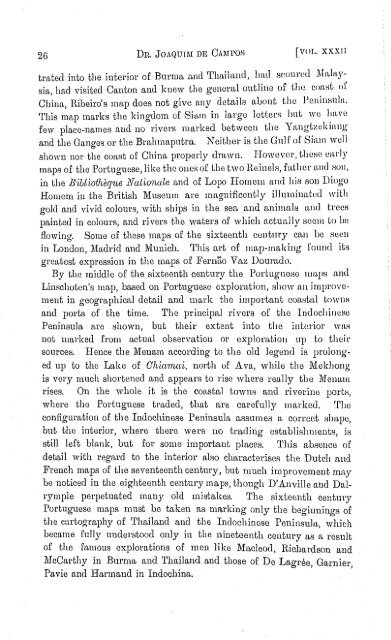The Journal of the Siam Society Vol. XXXII, 1940 - Khamkoo
The Journal of the Siam Society Vol. XXXII, 1940 - Khamkoo
The Journal of the Siam Society Vol. XXXII, 1940 - Khamkoo
Create successful ePaper yourself
Turn your PDF publications into a flip-book with our unique Google optimized e-Paper software.
26 Dn. JoAQUTl\I DE CAMPOK f.VOL. <strong>XXXII</strong><br />
trated into <strong>the</strong> interior <strong>of</strong> Bmma l1Ud rrlmilnllCl, had HeOlll'P(1 M:dttysia,<br />
had visited Canton and knew <strong>the</strong> geneml outli11e <strong>of</strong> tlw coast <strong>of</strong><br />
China, Ribeiro's map does not give any details 11Lont <strong>the</strong> Penimmla.<br />
This map marks <strong>the</strong> kingdom <strong>of</strong> Sittm in large letters but WB lmvu<br />
few place-names and no rivers marked between <strong>the</strong> Ynugt1.ekinug<br />
and <strong>the</strong> Ganges or <strong>the</strong> Brahmaputra. Nei<strong>the</strong>r is <strong>the</strong> Gnlf <strong>of</strong> Sian1 well<br />
shown nor <strong>the</strong> cmtst <strong>of</strong> China properly dmwn. However, <strong>the</strong>se e:trly<br />
maps <strong>of</strong> <strong>the</strong> PortuO"uese like <strong>the</strong> oneR <strong>of</strong> <strong>the</strong> two Heinels, fa<strong>the</strong>t· twtl Hou,<br />
in <strong>the</strong> Biblio<strong>the</strong>que<br />
"'<br />
Nationale<br />
'<br />
11nd <strong>of</strong> Lopo Homem and his son Diogo<br />
Homem in <strong>the</strong> British Museum are magnificently illuminated with<br />
gold and vivid colours, with ships in <strong>the</strong> sea and animalH aml trccH<br />
painted in colours, and rivers <strong>the</strong> waters o:f which actually Hecm to be<br />
flowing. Some <strong>of</strong> <strong>the</strong>se maps <strong>of</strong> <strong>the</strong> sixteenth century can l1e :-1een<br />
in London, Mad.rid and Munich. This art o:f map-rnakil1g found its<br />
greatest expression in <strong>the</strong> maps <strong>of</strong> Ferntto V IMI Dourado.<br />
By <strong>the</strong> middle <strong>of</strong> <strong>the</strong> sixteenth century <strong>the</strong> PortugneHo ll111p!'l uml<br />
Linschoten's map, based on Portuguese exploration, Hhow an improvement<br />
in geogruphical detail and mark <strong>the</strong> impOl'tant couHtal towuH<br />
and ports o:f <strong>the</strong> time. <strong>The</strong> principal rivers <strong>of</strong> <strong>the</strong> lncloehineHc<br />
Peninsula are shown, but <strong>the</strong>ir extent into <strong>the</strong> interior WHH<br />
not marked from a.ctual observation or explomtion up to tlteil'<br />
sources. Hence <strong>the</strong> Menam according to <strong>the</strong> old legend is prolonged<br />
up to <strong>the</strong> Lake <strong>of</strong> Ohiamai, north <strong>of</strong> Ava, while <strong>the</strong> Mekhong<br />
is very much shortened and appears to rise where reu,lly tbe Monam<br />
rises. On <strong>the</strong> whole it is <strong>the</strong> coastal towns and riverine portH,<br />
where <strong>the</strong> Portuguese traded, that are carefully warkecl. 'l'lte<br />
configmation <strong>of</strong> <strong>the</strong> Indochinese Peninsula assumes a corrcet shape,<br />
but <strong>the</strong> interior, where <strong>the</strong>re were no trading establishments, is<br />
still le:ft blank, but for some important places. 'l'his abseuce <strong>of</strong><br />
detail with regn,t·d to <strong>the</strong> interior also charactet'ises <strong>the</strong> Dutch and<br />
French maps <strong>of</strong> <strong>the</strong> seventeenth centmy, hut much improvement. m11y<br />
he noticed in <strong>the</strong> eighteenth century maps, though D'Anville and Dt:Llrymple<br />
perpetuated many old mistakes. 'l'he sixteenth century<br />
Portuguese maps must be taken as marking only <strong>the</strong> beginnings o£<br />
<strong>the</strong> cartography <strong>of</strong> rrhailaml and <strong>the</strong> Indochinese Peninsula, which<br />
became fully understood only in <strong>the</strong> nineteenth century as a result<br />
o:f <strong>the</strong> famous explomtions o£ men like Macleod, Hichardson and<br />
McCarthy in Burma and Thailand and those <strong>of</strong> De Lagree, Garnier,<br />
Pavie and Harmand in Indochina.

















